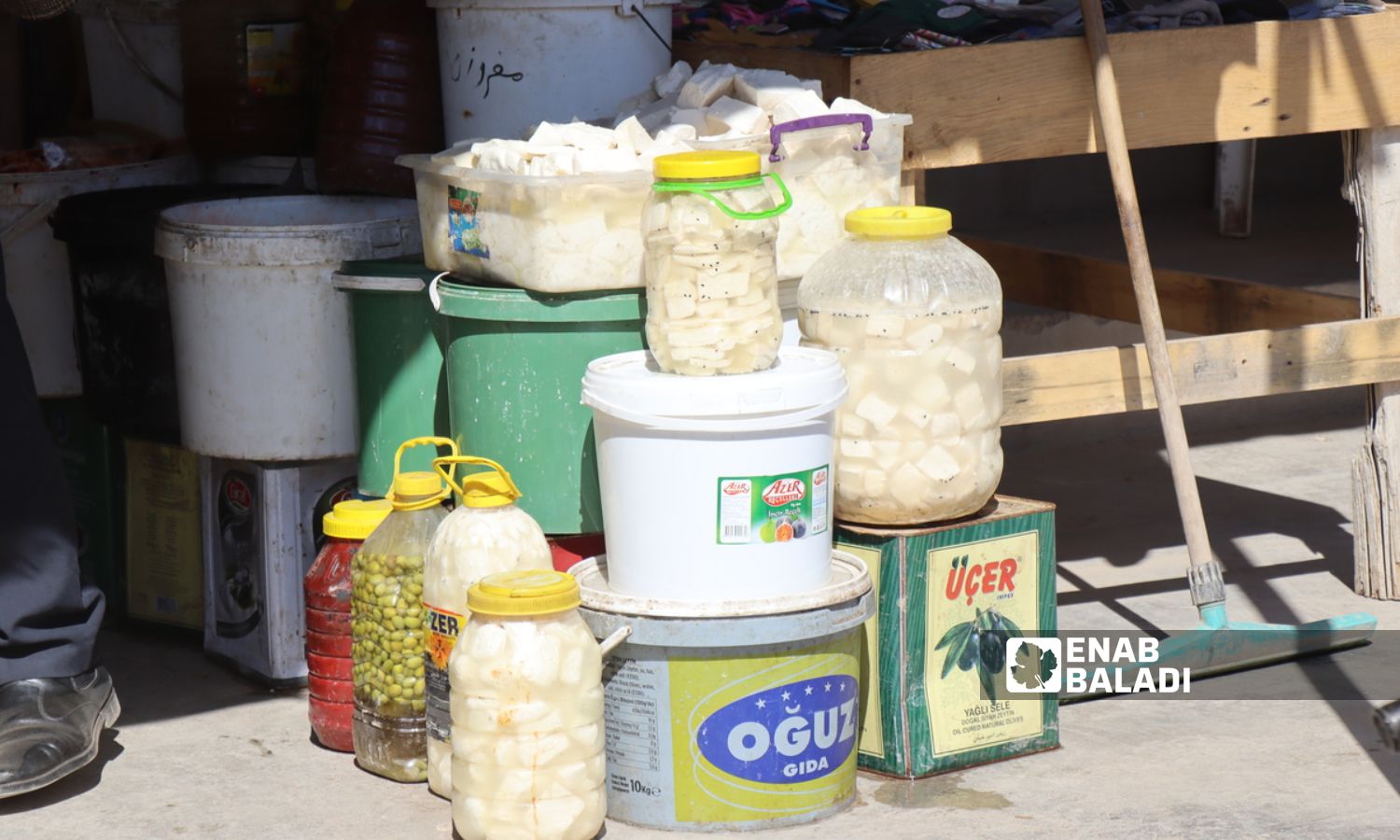



Enab Baladi – Ras al-Ain
Dairy products’ prices have reached unprecedented figures in Ras al-Ain, northwest of al-Hasakah, becoming unaffordable for most families, especially during the month of Ramadan, continuing their gradual increase despite the region’s wealth in livestock.
According to Enab Baladi‘s monitoring of dairy derivative prices in Ras al-Ain, the price of a kilogram of sheep milk has reached 17,000 Syrian pounds, cow milk 13,000 pounds, and goat milk 10,000 pounds.
The price per kilogram of cheese is 45,000 pounds, labneh 27,000 pounds, Arab ghee 150,000 pounds, and “Mushalal” cheese 52,000 pounds.
These prices are high, given that daily wages in Ras al-Ain range between 30,000 to 40,000 Syrian pounds (approximately two and a half dollars).
Wages differ based on the number of work hours and the nature of the profession, whether it be in agriculture or construction.
Despite the availability of pastures after the rains this year, and the number of sheep reaching 137,000 heads, this did not lower the prices of milk derivatives.
Laila Hammoud, a mother of three, told Enab Baladi that she was distressed by her inability to purchase cheeses and dairy in the needed quantity, especially during the current month of Ramadan.
She explained that she had purchased half a kilo of milk and 300 grams of cheese to prepare the Suhoor meal, which is half the amount her family consumes daily.
She mentioned that during Ramadan in 2023, she bought over 20 kilos of cheese and used two kilograms of milk daily to prepare desserts and the Suhoor and Iftar meals.
The lady appealed to the commercial shops to set acceptable prices for dairy products, as they are essential items for most families.
For his part, Fadi al-Soufi, a worker in a blacksmith’s shop in Ras al-Ain, said that this was the first time he had bought dairy derivatives in grams, and he bought 250 grams of cheese for the first Suhoor of Ramadan.
He mentioned to Enab Baladi that his daily wage at the blacksmith’s shop does not exceed 45,000 Syrian pounds (equivalent to three dollars), which is not enough to secure most of his family’s needs.
Regarding the reasons for the price increase, Enab Baladi spoke with merchants, shop owners, and the Supply Directorate in Ras al-Ain, who attributed this to the fact that breeders sell or calculate their products in US dollars, then the seller prices them in Syrian pounds.
Three different currencies circulate in the city of Ras al-Ain, complicating the commercial transactions of the residents.
The Syrian pound is the most common currency, while the second currency, the Turkish lira (not widely used) is due to the city’s proximity to the Turkish border, and the third is the US dollar.
Every US dollar is equivalent to 14,400 Syrian pounds, and the Turkish currency’s exchange rate is 32 pounds, according to the S-P Today website, which specializes in currency exchange rates.
Yazan al-Daher, a shop owner, said that livestock breeders have raised the price of dairy products four times during the past seven months, citing low profits, and the depreciation of the Syrian pound and Turkish lira.
He explained that he bought 40 kilograms of cheese and 30 kilograms of labneh before the beginning of Ramadan but sold only six kilograms of cheese and two of labneh.
He added that he would return the remaining quantity due to difficulty in selling it in the market, low demand, the cost of storing it, and the need for a refrigerator running 24 hours.
Meanwhile, the deputy director of the Supply Directorate in the Local Council of Ras al-Ain, Mohammed al-Qadi, said that the lack of a stable currency and residents dealing in Syrian pounds led to instability in the market for products.
He clarified that the Directorate of Supply Control and Consumer Protection conducts constant rounds on commercial shops to control prices. However, due to dealing in Syrian pounds, prices remain variable throughout the day.
He pointed out that the directorate will work intensively during Ramadan to set prices appropriate to the currency exchange rates.
Sheep farming in Ras al-Ain and the eastern rural areas of Syria is one of the pillars of the local economy, and the “Awassi” breed constitutes the largest portion of sheep in Ras al-Ain, along with other hybrid types such as “Hamdani” and “Hamwi”.
According to the statistics of the Directorate of Agriculture in Ras al-Ain, about 2,750 families, out of approximately 18,000 families in the countryside and the city, mainly depend on livestock breeding as a primary means of livelihood.
if you think the article contain wrong information or you have additional details Send Correction